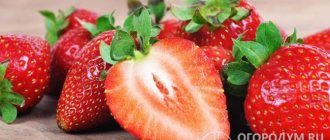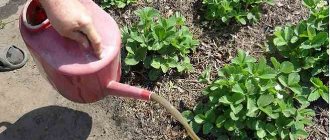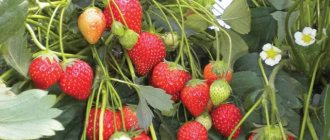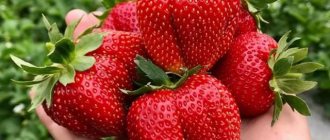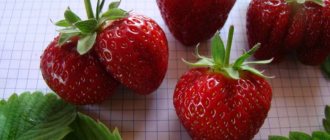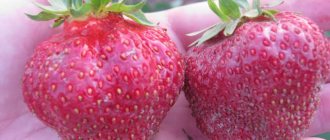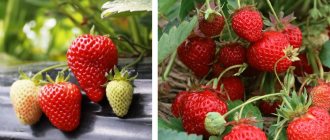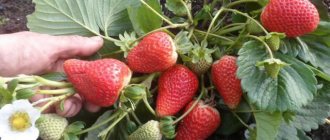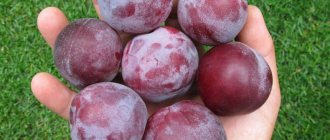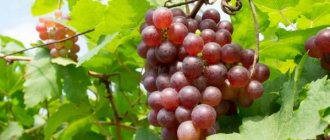Characteristics
The described strawberry variety Fresco has an early ripening period and high productivity. It produces many harvests over the course of a whole season. Up to 1.5 kg of fragrant, tasty berries are collected from one bush.
Fresco is suitable for cultivation not only in the garden, but also in pots on the balcony. The variety is unpretentious to care and soil type. It has excellent disease resistance, adapts perfectly to any climatic conditions, and is not sensitive to daylight hours.
This variety is used for homemade preparations in the form of jam, juice, compotes, jam.
The Fresco variety is very suitable for transportation over long distances. It can withstand a long journey without damage. The use of the Fresco variety for commercial purposes is quite widespread.
Popular varieties of remontant strawberries
Modern gardeners, unlike their older colleagues, can easily purchase remontant strawberry seeds and seedlings. A specialized store or agricultural company has in stock many varieties of crops that bear fruit several times per season. Each of them has its own unique properties. Gardeners give preference to varieties that are especially sweet and tasty, with large, firm and fleshy berries. In addition to taste, the culture’s resistance to microbes, diseases, and transportation is taken into account.
Read also: Garden strawberries: post-harvest care and feeding
Popular brands include:
Distinctive features
The bushes of the Fresco variety are strong, compact, up to 30 cm high, with beautiful leaves of a brilliant green color. Many flower stalks grow just below the level of the leaves. Fresco strawberry blooms with large white flowers.
The Fresco variety produces deep red, one-dimensional, cone-shaped berries with a wonderful strawberry aroma. The fruit pulp is juicy, dense, sweet, with a slight sourness, which gives strawberries their unique taste. Average weight is 25 g.
The variety is capable of producing a harvest already in the very first year of planting, and quite high - from 0.7 kg to 1.3 kg per square meter.
Fresco practically does not grow a mustache, so propagation is carried out mainly by seed. If the mustache does appear, then it immediately blooms and bears fruit.
Remontant strawberry “Fresco f1”: description and cultivation
Remontant strawberry “Fresco f1” is one of the best and most popular large-fruited varieties with high taste characteristics. The unpretentious new hybrid form of garden strawberries is early ripening and highly productive, feels great in any cultivation region and is not sensitive to changes in daylight hours.
Characteristics of the variety
Garden remontant strawberry "Fresco-f1" forms well-developed and powerful bushes. The average height of the plant is 25-30 cm. Strawberry bushes are characterized by increased resistance to major diseases and have excellent productivity. The number of flower stalks on the bush is significant.
The berries are quite dense, bright red in color, 2-3 cm in diameter. The average weight of a marketable berry at the stage of mass harvest formation can vary from 10 to 20 g. The taste of the berry pulp is very pleasant, sweet and sour. High productivity, universal use.
The value of this hybrid form is: resistance to major diseases, unpretentiousness to growing conditions, high winter hardiness, resistance to high temperatures.
Landing requirements
Remontant garden strawberries “Fresco f1” are most often grown from seed material sold by official producers. The main condition for obtaining high-quality seedling material is compliance with the timing of sowing and planting in open ground.
| Seed sowing time | Time for planting seedlings | Standard planting pattern | Fruiting period |
| From February 20 to March 10-15 | In open ground from June 1 to June 10. In the greenhouse from May 10 to June 1 | Using the square-cluster method according to the usual pattern of 30x20 cm or the two-line method with row spacing of 30-35 cm and a distance between bushes of at least 15-25 cm | On personal plots in central Russia from June 20 to October 10 |
The soil mixture for sowing seeds should consist of 3 parts sand and 5 parts crumbly and high-quality humus. It is recommended to disinfect the soil in the oven for at least 3-4 hours at a temperature of 90-100 °C. Sowing is carried out on top of moistened and disinfected nutrient soil, and then covered with plastic film.
In the phase of two true leaves, strawberry seedlings should be planted in separate seedling pots and the air temperature should be lowered to 14-16 °C. High-quality seedlings, suitable for planting in open ground or a greenhouse, are strong and stocky, they have at least five true leaves.
Features of care
The description of the variety assumes standard technology for cultivating berries. The remontant strawberry of the hybrid form “Fresco-f1” is unpretentious in care and has high rates of adaptability to adverse weather and climatic conditions.
The main conditions for obtaining a high and high-quality harvest are the duration of daylight hours at 15-17 hours, as well as air temperatures at the active flowering stage within 21-25 ° C.
In addition, the plant needs the following care measures:
- Irrigation activities at the planting site should be carried out with water heated in the sun as the soil dries, but the optimal result is achieved by using a modern and effective drip irrigation system for gardening, berry and vegetable crops, which allows you to moisten the soil at the depth of the plant root system.
- When using a drip irrigation system, it is allowed to apply liquid fertilizers and mulch strawberry plantings with organic matter in the form of peat, dry grass or sawdust, as well as high-quality, breathable agrofibre. Mulching plantings protects the soil and root system of berry plants from overheating, reduces the loss of marketable berries from fruit rot, and also reduces the need for weeding and loosening the soil.
- Loosening the soil after watering or heavy rainfall is a mandatory measure to prevent the formation of a soil crust and help destroy the roots of weeds and significantly improve the air permeability of the soil.
- In order to protect strawberry bushes from the most common diseases in berry plantings, it is allowed to use karbofos at the rate of 60 g per 10 liters of water or spray the plants before the start of the growing season with 3-4% Bordeaux mixture. To protect strawberry bushes from pests in the spring, at the stage of growing new leaves, it is recommended to spray the plants with a folk remedy such as wormwood decoction.
- In the fall, you should definitely take care of the safe wintering of strawberry bushes. To get a decent berry harvest for the next year, it is recommended to feed strawberries in the fall with complex fertilizers. It is necessary to trim the leaves and tendrils of garden strawberries with thin pruning shears or clean, sharp garden shears, and then use a mulch layer and cover the strawberry bushes with spruce branches to protect them from freezing.
Reviews from gardeners
An early-ripening, remontant hybrid form of garden strawberry “Fresco f1” is perfect for fresh consumption, and is also in demand for making preserves, making jam and compote. According to gardeners, the entire berry has a simply ideal shape and is quite large. The taste of the pulp cannot be expressed in words: it is sweet, but with a slight sourness and a very pleasant aftertaste.
Already in the first year after sowing, the yield of each bush reaches 0.81–3 kg. After formation, the mustache immediately begins to bloom profusely.
In garden plots, this variety of garden strawberry is quite often grown as a potted crop and, according to gardeners, it looks good as a decorative element in hanging flowerpots.
The hybrid form is popular in industrial use, including one-year cultivation technology and growing commercial berries in the autumn-winter period.
How to prepare strawberries for planting (video)
:
(6 4,67 of 5) Loading...
Source: https://DachaDecor.ru/yagodi/remontantnaya-klubnika-freska-f1-opisanie-i-viraschivanie
Garden strawberry remontant “Fresco f1” is an early-ripening variety with long-term fruiting
The breeding of remontant strawberry varieties by breeders allowed gardeners to continuously obtain a sweet and aromatic berry harvest for 5 summer-autumn months. Among the most popular varieties of remontant strawberries, the hybrid variety “Fresco f1” should be highlighted, a description of the characteristics, photos and reviews of which are presented in this article.
Features of the variety
The new remontant strawberry hybrid “Fresco f1” is characterized as an early-ripening, large-fruited, highly productive variety with a long fruiting period.
Characteristic features of strawberries “Fresco f1”:
- strong compact bush up to 30 cm high;
- practically does not form a mustache;
- a large number of peduncles;
- bright red berries up to 3 cm in diameter and weighing about 20 g.
This hybrid variety is highly resistant to fungal diseases and some types of pests, such as mites. Adapts well to almost any weather conditions, withstanding significant decreases or increases in temperature and shortened daylight hours.
Attention! Due to its high decorative qualities and unpretentiousness, strawberries “Fresco f1” can be grown as a potted crop on a window or balcony, as well as in hanging pots on a terrace, veranda or gazebo.
A characteristic feature of the variety is its ability to produce a yield of 0.8 kg to 1.3 kg per 1 sq.m. in the first year of cultivation. In subsequent years, the yield increases to 1.5-2 kg. Fruiting occurs 5-6 months after germination and lasts from June to October with short breaks - up to 2 weeks after each major harvest.
The berries have excellent commercial and taste qualities:
- large;
- juicy;
- with sweet and sour dense pulp;
- characteristic aroma;
- Suitable for fresh consumption, as well as preparations.
Due to the properties of forming a limited number of whiskers, this variety is propagated mainly by seed.
Reviews from gardeners about growing strawberries “Fresco f1”
Irina Semenovna, Belgorod: “It’s a good, productive variety, not picky, and doesn’t get sick. The only difficulty was growing seedlings from seeds - we had to tinker a lot, but the result did not disappoint - we collect berries all summer and half of the autumn.
For the winter, despite the declared frost resistance, I cover it with fallen leaves and sawdust, just in case. In the spring, I remove the cover, water it well, feed it with organic matter, and mulch. Among the maintenance requirements, the main thing is regular watering, because drying out of the soil leads to a decrease in yield.
I pick the berries as they ripen, use them fresh or make jam. The taste of strawberries is very pleasant, sweet with a slight sourness.”
Tamara Anatolyevna, Saransk: “I grow strawberries “Fresco” on my balcony. It all started with a desire to plant flowers on the balcony. When I was selecting seeds for planting, the seller advised me to try growing remontant strawberries - beautifully and usefully. I sowed the seeds in the first half of March, and a week later they had already hatched, but they were thinner than a thread.
As they grew, the seedlings grew stronger, becoming more and more like strawberry bushes. Already at the beginning of May they had grown and become so strong that I was able to transplant them into separate pots, and by the end of the month, take them out onto the balcony. After another 2-3 weeks, the first berries appeared - sweet and aromatic.
I grew 4 bushes that bloomed continuously, allowing me to pick 1-2 dozen berries every week. In mid-autumn the bushes began to dry out and fruiting stopped.
The pots of strawberries survived the winter in the apartment on the windowsill, practically losing all the foliage, but with the arrival of April, young leaves began to appear and as soon as warm weather settled in, I again took the pots out onto the balcony. So I’ve had it for 3 years now and it’s growing.”
Growing modern remontant strawberry varieties from seeds is becoming increasingly popular among gardeners. By choosing the Fresco f1 hybrid for this purpose, you will always have a harvest.
The best varieties of garden strawberries - video
Strawberries, or strawberries as they are also called, are one of the most common garden berries in the garden.
There are a lot of varieties of it - some of them ripen at the beginning of summer, others in the middle, and some are capable of producing crops several times a season each year. The latter includes the hybrid Fresco F1.
This is a large-fruited remontant variety. The best way to tell about it is reviews from gardeners, a detailed description of this variety and photographs.
Characteristics and description of the variety
- One of the best remontant varieties.
- The hybrid tolerates winter well and is resistant to most strawberry diseases. Tolerates heat and lack of watering well.
- The bushes are quite voluminous, well developed, with dark green leaves. Reach 20-30 cm in height.
- Peduncles are tall. There can be 7-8 of them on each bush. The flowers are white.
- In the middle zone, the harvest can be harvested from late June to early October.
- The berries are red, large, 2-3 cm in diameter, and have the shape of a cone.
- The berries have an excellent taste, the aroma is pronounced.
- The hybrid has proven itself well when grown in heated greenhouses. In open beds, high yields are also harvested from it.
Strawberry seeds Fresco
How to grow hybrid Fresco F1
To obtain high-quality planting material for large-fruited remontant strawberries, it is recommended to grow seedlings from seeds offered by the manufacturer. It is very convenient to sow in peat tablets.
With this method, the seeds will not get lost in large containers, you will not need to worry about preparing the soil mixture, and there will be no need for picking. If the timing of sowing and planting is observed, the harvest from plants can be obtained already in the first year after planting.
In the middle zone, you need to sow on the twentieth of February, and plant in a permanent place after June 10.
Advice. Strawberry seedlings are demanding on lighting, so in the first month after seed germination it is better to provide additional illumination with fluorescent lamps.
Soaking and stratification of garden strawberry seeds
Strawberry seeds are carefully laid out on a damp cotton pad or cloth flap. The disk is then placed in a plastic container or other container, closed loosely to allow the seeds to breathe, and left in a warm place.
After 2-3 days, the containers are moved to the refrigerator for 2 weeks. After stratification, containers with seeds are placed in a well-lit, warm place until the sprouts hatch.
How to sow strawberries in peat tablets
- Peat tablets are filled with water and kept in it until they swell.
- The sprouted seeds are placed one by one into the recesses on the tablets.
Advice. It is very convenient to spread the sprouted strawberry seeds using a toothpick.
- There is no need to sprinkle the seeds on top with soil. The main thing is to make sure that they do not dry out, for which the tablets are placed in a box and closed with a transparent lid (polyethylene or glass).
- After two true leaves grow, the covering is removed and the roots of the plants are covered with earth.
- Peat tablets with seedlings should be periodically immersed in water to moisturize.
Strawberry shoots
A month before planting in the garden, seedlings should be hardened off by moving them out of the room to a cooler place, for example, on a glazed balcony.
Reviews from gardeners about strawberries Fresco F1
Gardeners who have already grown the hybrid Fresco F1 speak of this variety as unpretentious and productive. The taste of strawberries and the almost ideal shape of the berries received high scores. The Fresco F1 variety is perfectly suited for growing berries in the autumn-winter period when organizing a strawberry business.
Garden remontant strawberries of the Fresco F1 variety can please you not only with delicious berries. Its lush bushes, strewn with flowers and berries for a long time, will become a real decoration of the site.
Sowing strawberries Fresco: video
Source: https://Ogorodnik8.ru/klubnika/klubnika-freska-opisanie-sorta.html
Sowing
To sow seeds of the Fresco variety for seedlings, you should prepare a soil mixture of the following composition:
- 3 parts river sand;
- 5 parts of high-quality humus;
After mixing these components, the mixture is disinfected in the oven for about four hours at a temperature of 100 C.
For successful seed germination, appropriate conditions are required. The light illuminating the seedlings must be on for at least 12 hours a day, and the air temperature in the room where the plastic box with seeds is located must be at least 22 degrees Celsius. For long-term illumination, fluorescent lamps should be used.
Before sowing, the seeds must be placed in a plastic container on a damp cloth and kept there for several days. Next, the container with the seeds is placed in the refrigerator. Do not close the container tightly, as the seeds may suffocate. The optimal sowing time is mid-February. Fresco strawberries are planted in open ground around the beginning of June.
The soil prepared for sowing is moistened with warm water. Then the planting material is laid out on the surface of the soil mixture without sprinkling. Cover the container with a lid or plastic wrap. Watering the seedlings is done from a spray bottle. The film or lid of the container is periodically removed for several hours for ventilation.
After the shoots appear, you need to wait for the leaves to grow. When the strawberry seedlings produce 2 leaves, they are transplanted into separate cups or peat tablets. Pickled seedlings also need watering, which is done with warm water under each sprout. The air temperature when growing strawberry seedlings in cups should be reduced to 14-16 degrees. This will allow the seedlings to harden. Seedlings are planted on the garden bed when 5-6 leaves form.
Remontant strawberry “Fresco”: how to grow a hybrid in the garden
Thanks to the hard work of breeders, remontant strawberry varieties have improved characteristics, are more resistant to climatic conditions and, most importantly, produce several harvests per season.
This article will tell you about one of these varieties, the “Fresco” strawberry.
Strawberry “Fresco”: description and characteristics
This variety is distinguished by strong bushes up to 30 cm in height; the bushes produce many inflorescences and bear fruit productively. The variety has increased resistance to changes in weather conditions and immunity against many crop diseases.
Strawberry “Fresco” in the description of the variety is presented as a very productive crop: in the first year of fruiting, up to one and a half kilograms of berries are harvested per square meter. The berries are rich red in color, weighing up to 20 grams, and are distinguished by dense, juicy pulp with a sweet and sour taste. The aroma of the fruit is strong and pleasant.
The plant begins to bear fruit five months after planting; the fruits are harvested several times from June to October.
Conditions for landing
This variety is propagated by seeds; sowing seedlings can be done at home, while observing several rules.
Soil for sowing
To prepare a high-quality substrate for seedlings, you need to take sand and crumbly humus in a ratio of 3:5. The soil mixture needs to be disinfected: place it in the oven for three to four hours at a temperature of about one hundred degrees.
Lighting and temperature
In order for all seeds to germinate successfully, they need to be provided with the proper conditions: bright light for at least 12 hours a day, room temperature up to 22 degrees Celsius. For long-term lighting you will need to use fluorescent lamps. The seedlings will need to be ventilated periodically by removing the film from it.
Landing technology
Before sowing, the seeds undergo a stratification procedure: the seeds are laid out on a piece of damp cloth and placed in a plastic container in a warm place for several days, then in the refrigerator for two weeks. This process will help the seeds to “hatch”.
Timing of sowing seeds
Seeds are sown in mid-February; mature seedlings are transplanted into open ground in early June.
Planting scheme
Planting material is distributed over the surface of the prepared moistened soil; it is not covered with soil. The container with the crops is covered with film and placed in a warm place. It is important to sow in moist soil and not water later, so as not to wash away the seeds. The seedlings are planted in a checkerboard pattern at a distance of 25-30 cm from each other.
Caring for seedlings and subsequent planting in open ground
Caring for seedlings involves moistening the soil by spraying and maintaining the temperature; sowing also needs lighting.
The seedlings are ready to be transplanted to the site when five leaves appear on the plant. A week before transplanting, the seedlings are gradually hardened.
Before planting, thoroughly clean the area of weeds and fertilize it: add 30 g of ammonium nitrate and potassium salt and 70 g of superphosphate per ten liters of humus. Planting technology :
- the soil in the beds is carefully loosened with a rake;
- make 30x30 holes and water them with water;
- bushes are planted vertically, straightening the root system;
- the root collar remains above the ground line;
- The planted bushes are watered and mulched.
Secrets of care
After the first portion of the harvest, remontant strawberries are pruned - the foliage is cut off, while only the leaf plate is cut so as not to damage the growing point.
Features of watering
Strawberries require regular and moderate watering; it is best to use the drip irrigation method, which allows you to evenly distribute moisture both over the surface and deep into the soil. In this case, warm water is used, the frequency of watering depends on the speed of drying of the soil surface.
Soil care
Throughout the growing season, the soil in the garden bed must be loosened, breaking the crust and allowing air access to the root system.
Weeding and weed removal are carried out regularly. Mulch on the beds will protect the soil from moisture evaporation and the roots from overheating; if there is mulch, there will be no need for frequent weeding and loosening.
Top dressing "Frescos"
During the growing season, plantings are fed with nitrogen and potassium; for this, herbal infusions, slurry or compost mash are prepared. Liquid fertilizers are especially relevant for drip irrigation systems. Feed the plant before flowering and before fruiting.
Protection from diseases and pests
To protect plants from diseases, spray with Bordeaux mixture before flowering. Karbofos is also used as a preventive measure: 60 g of the substance per 10 liters of water.
Strawberry "Fresco" is a remontant variety that is resistant to diseases; it is more threatened by insects. To combat them, they mainly use folk methods :
- infusion of garlic cloves;
- wormwood decoction;
- infusion of tomato tops.
To distract ants from strawberries, jars of sweet water are placed around the perimeter of the garden bed, and plastic bags left on sticks sticking out next to the bushes help keep birds away. To prevent slugs, broken egg or nut shells are scattered around the area.
Features of wintering garden strawberries
The strawberry variety “Fresco” is resistant to frost, but it is still worth preparing for winter. To get a good harvest next year, beds with strawberries should be fed for the winter after harvesting with preparations with a complex composition.
Using scissors or pruning shears, the leaves, tendrils, and new rosettes that have managed to form are trimmed from the bushes. All this is removed before winter, leaving only stems and old bushes. They do this so that food and energy are not wasted in winter.
After pruning, the bushes are mulched with a dense layer of peat.
In winter, the best covering material for plants is snow. The more it is, the warmer it is. Many experienced gardeners leave branches cut from trees among the beds: they prevent the snow from melting and help form snowdrifts.
Harvesting
When growing remontant varieties of strawberries, you should know that the first harvest of berries is usually not the largest, which disappoints many. However, the subsequent August harvest will delight you with both quality and quantity.
The strawberry variety “Fresco” bears fruit for about five months: from June to October. Ripe red berries are picked by hand. Try not to let them overripe - the berries will squish in your hand.
In order not to damage the berries, it is better to remove them with the stem with scissors.
Starting from the ripening period, harvesting is carried out almost every day; the process takes place in the morning or evening hours in dry weather. Then the berries are sorted and sorted. If the fruits are being prepared for transportation, then during assembly they are immediately placed in boxes covered with parchment.
Advantages and disadvantages of the variety
The main advantages of the variety are:
- frost resistance;
- resistance to heat;
- disease resistance;
- high productivity;
- long fruiting;
- good transportability indicators;
- excellent taste characteristics.
The only drawback is the rapid depletion of the crop due to frequent fruiting. Plants begin to get sick, weaken and produce small fruits. To summarize the above, I would like to add one more undeniable advantage of the “Fresco” variety - this strawberry is universal in use, it is consumed fresh, prepared in salads, desserts, sauces and stored for the winter.
Source: https://agronomu.com/bok/2917-remontantnaya-klubnika-freska-kak-vyrastit-gibrid-v-sadu.html
Source: https://img59.ru/2016/02/09/remontantnaja-klubnika-freska-kak-vyrastit-gibrid/
Landing
A place for planting remontant strawberries of the Fresco variety is chosen taking into account the following conditions:
- Maximum sun exposure of the place where the strawberries will grow.
- Strong wind action is unacceptable.
- The occurrence of groundwater must be at a depth of at least 0.6 meters to the surface.
- The soil type is neutral or slightly acidic.
Before planting, the ridge is prepared in advance - about 2 weeks. Weeds are completely removed from the strawberry plot. The soil is dug up on the bayonet of a shovel, while fertilizing is applied.
A lot of fertilizers are required, both organic and mineral. Add humus or rotted manure (a bucket per square meter). Wood ash (a glass per square meter) or superphosphate (70 g) and potassium salt (30 g) are also added to saturate the soil base with minerals.
Planting of the Fresco variety is carried out using a two-line scheme:
- between plants – 15-20 cm;
- between rows – 30-35 cm.
Dig holes measuring 30 by 30 cm. Moisten them. Then the seedlings are placed in them, straightening the roots well. The soil around the bushes is compacted; the root collar of the plant is not covered with soil. After planting, strawberries are watered abundantly. Water the planted bushes every other day until they take root well.
Strawberry Fresco: characteristics of the variety, sowing, planting, care
It is worth starting the description of the Fresco strawberry variety with the main characteristics of this type of berry. Strawberry Fresco is a remontant variety, that is, it bears fruit several times during the season. Moreover, fertility is very high in strawberries of this type. A lot of gardeners choose Fresco, considering it one of the most productive varieties.
Characteristics
The described strawberry variety Fresco has an early ripening period and high productivity. It produces many harvests over the course of a whole season. Up to 1.5 kg of fragrant, tasty berries are collected from one bush.
Fresco is suitable for cultivation not only in the garden, but also in pots on the balcony. The variety is unpretentious to care and soil type. It has excellent disease resistance, adapts perfectly to any climatic conditions, and is not sensitive to daylight hours.
This variety is used for homemade preparations in the form of jam, juice, compotes, jam.
The Fresco variety is very suitable for transportation over long distances. It can withstand a long journey without damage. The use of the Fresco variety for commercial purposes is quite widespread.
Distinctive features
The bushes of the Fresco variety are strong, compact, up to 30 cm high, with beautiful leaves of a brilliant green color. Many flower stalks grow just below the level of the leaves. Fresco strawberry blooms with large white flowers.
The Fresco variety produces deep red, one-dimensional, cone-shaped berries with a wonderful strawberry aroma. The fruit pulp is juicy, dense, sweet, with a slight sourness, which gives strawberries their unique taste. Average weight is 25 g.
The variety is capable of producing a harvest already in the very first year of planting, and quite high - from 0.7 kg to 1.3 kg per square meter.
Fresco practically does not grow a mustache, so propagation is carried out mainly by seed. If the mustache does appear, then it immediately blooms and bears fruit.
Sowing
To sow seeds of the Fresco variety for seedlings, you should prepare a soil mixture of the following composition:
- 3 parts river sand;
- 5 parts of high-quality humus;
After mixing these components, the mixture is disinfected in the oven for about four hours at a temperature of 100 C.
For successful seed germination, appropriate conditions are required. The light illuminating the seedlings must be on for at least 12 hours a day, and the air temperature in the room where the plastic box with seeds is located must be at least 22 degrees Celsius. For long-term illumination, fluorescent lamps should be used.
Before sowing, the seeds must be placed in a plastic container on a damp cloth and kept there for several days. Next, the container with the seeds is placed in the refrigerator. Do not close the container tightly, as the seeds may suffocate. The optimal sowing time is mid-February. Fresco strawberries are planted in open ground around the beginning of June.
The soil prepared for sowing is moistened with warm water. Then the planting material is laid out on the surface of the soil mixture without sprinkling. Cover the container with a lid or plastic wrap. Watering the seedlings is done from a spray bottle. The film or lid of the container is periodically removed for several hours for ventilation.
After the shoots appear, you need to wait for the leaves to grow. When the strawberry seedlings produce 2 leaves, they are transplanted into separate cups or peat tablets.
Pickled seedlings also need watering, which is done with warm water under each sprout. The air temperature when growing strawberry seedlings in cups should be reduced to 14-16 degrees.
This will allow the seedlings to harden. Seedlings are planted on the garden bed when 5-6 leaves form.
Landing
A place for planting remontant strawberries of the Fresco variety is chosen taking into account the following conditions:
- Maximum sun exposure of the place where the strawberries will grow.
- Strong wind action is unacceptable.
- The occurrence of groundwater must be at a depth of at least 0.6 meters to the surface.
- The soil type is neutral or slightly acidic.
Before planting, the ridge is prepared in advance - about 2 weeks. Weeds are completely removed from the strawberry plot. The soil is dug up on the bayonet of a shovel, while fertilizing is applied.
A lot of fertilizers are required, both organic and mineral. Add humus or rotted manure (a bucket per square meter). Wood ash (a glass per square meter) or superphosphate (70 g) and potassium salt (30 g) are also added to saturate the soil base with minerals.
Planting of the Fresco variety is carried out using a two-line scheme:
- between plants – 15-20 cm;
- between rows – 30-35 cm.
Dig holes measuring 30 by 30 cm. Moisten them. Then the seedlings are placed in them, straightening the roots well. The soil around the bushes is compacted; the root collar of the plant is not covered with soil. After planting, strawberries are watered abundantly. Water the planted bushes every other day until they take root well.
Care
Strawberry Fresco is unpretentious in care. It only requires standard agricultural practices, and in return gives a good harvest.
Watering should be moderate and regular. There is no need to flood the strawberries, but it is also unacceptable to allow the soil to dry out. There is no need to water strawberries when it rains. Weather conditions for irrigation play a decisive role.
Loosening the soil is carried out after each watering or rain to remove the hard earth crust that forms after wetting.
Many gardeners use mulching beds with straw, grass, sawdust, or using a special black cloth. This is a very effective way to retain moisture. In addition, when fighting weeds, breathable agrofibre is indispensable. Weeds do not grow, and strawberries are in fairly comfortable conditions.
The beds are covered with agrofibre before planting, cutting holes for each seedling. After collecting the first wave from the Fresco variety, the leaves should be carefully trimmed without touching the growth point.
Feeding
Strawberries of the Fresco variety require regular fertilizing, since they bear fruit until autumn, and they require large amounts of nutrients.
During the growing season, saturate the soil with nitrogen and potassium by adding a solution of urea or chicken manure (1:20), compost or herbal infusion. Complex mineral fertilizers, which can be purchased at a special store, will also be effective.
In total, at least 8 additional fertilizers are required for the Fresco variety per season. Enrichment of the soil with nutrients is carried out before flowering and fruiting.
In the fall, when the last harvest has already been made, the strawberries are fed with mineral fertilizers. Nitrogen should not be present in the last fertilizing, as it can prevent the strawberry bushes from preparing for winter. In winter, strawberries of the Fresco variety are covered with a thick layer of mulch made from straw, foliage, or coniferous spruce branches.
Harvesting
Fresco strawberries are usually harvested by hand. Overripeness should not be allowed, because overripe fruits become wrinkled in the hands and, accordingly, are damaged. It is recommended to collect fruits with scissors, carefully cutting off the stalk.
The fruits are harvested almost every day. The fruits are harvested mainly in the morning or evening, in dry, windless weather. Then the berries are sorted, sorted and prepared either for transportation, placed in boxes (when used for commercial purposes), or for homemade preparations.
Sustainability
The strawberry variety Fresco is quite resistant to all types of fungal diseases and pest damage. Preventive measures are still needed to protect plants. It is recommended to protect strawberries from common diseases. It is acceptable to use karbofos (60 g per 10 liters of water) during flowering.
Folk remedies are used to protect against pests:
- scatter tobacco dust or mustard powder between the rows;
- marigolds, marigolds or onions and garlic are planted near strawberries;
- scatter eggshells to repel slugs;
- spray the strawberries with a solution consisting of a mixture of laundry soap and dry mustard.
It is possible to use fungicidal preparations Fufanon, Aktara, etc. to protect strawberries from weevils and mites. Strawberry processing begins in the spring, and is carried out before and after flowering. To protect against ticks, an infusion of pine needles is also used, which is prepared as follows.
One kg of pine needles is used, which needs to be filled with 4 liters of water. Leave for a week, stirring every day. After a week, the resulting liquid is mixed with clean water (1:1), and each strawberry bush is sprayed with it.
A decoction of celandine is used to protect strawberries from pests. You should take 400-450 g of only plucked stems with celandine flowers, add a liter of water, and leave for 2-3 days. Then this infusion is boiled for 20 minutes. It is also possible to take dried celandine, but this will require only 100 g of this herb.
Advantages and disadvantages
The strawberry variety Fresco has many of the following advantages:
- Long-term fruiting.
- Early maturation.
- Delicious, aromatic fruits.
- Possibility of growing on the balcony for decoration.
- Versatility of use.
- Resistance to diseases and damage from dangerous insects.
- Easy to care for.
- Remarkable transportable properties.
The Fresco variety has disproportionately few disadvantages compared to its advantages. One can only note the rapid depletion of the berry crop. Since the Fresco strawberry variety is remontant and bears fruit for a long time, in subsequent years of life the bushes produce slightly smaller fruits. In addition, plants are more susceptible to diseases in subsequent seasons.
Conclusion
Strawberries of the Fresco variety are very popular among gardeners. This beautiful plant with wonderful berries can be grown not only in the garden, but also in pots or flowerpots on balconies and terraces for interior decoration.
In addition, the Fresco variety is very tasty berries, which are consumed both fresh and as preparations for the winter.
Many gardeners grow the Fresco variety on their plots because it is high-yielding and resistant to diseases and pests.
Source: https://VashaKlubnika.ru/sort/klubnika-freska
Care
Strawberry Fresco is unpretentious in care. It only requires standard agricultural practices, and in return gives a good harvest.
Watering should be moderate and regular. There is no need to flood the strawberries, but it is also unacceptable to allow the soil to dry out. There is no need to water strawberries when it rains. Weather conditions for irrigation play a decisive role.
Loosening the soil is carried out after each watering or rain to remove the hard earth crust that forms after wetting.
Many gardeners use mulching beds with straw, grass, sawdust, or using a special black cloth. This is a very effective way to retain moisture. In addition, when fighting weeds, breathable agrofibre is indispensable. Weeds do not grow, and strawberries are in fairly comfortable conditions.
The beds are covered with agrofibre before planting, cutting holes for each seedling. After collecting the first wave from the Fresco variety, the leaves should be carefully trimmed without touching the growth point.
Remontant strawberry - a delicious garden berry of the Fresco F1 variety
Thanks to the hard work of breeders, remontant strawberry varieties have improved characteristics, are more resistant to climatic conditions and, most importantly, produce several harvests per season.
This article will tell you about one of these varieties, the “Fresco” strawberry.
Reviews from gardeners about growing strawberries “Fresco f1”
Irina Semenovna, Belgorod: “It’s a good, productive variety, not picky, and doesn’t get sick. The only difficulty was growing seedlings from seeds - we had to tinker a lot, but the result did not disappoint - we collect berries all summer and half of the autumn.
For the winter, despite the declared frost resistance, I cover it with fallen leaves and sawdust, just in case. In the spring, I remove the cover, water it well, feed it with organic matter, and mulch. Among the maintenance requirements, the main thing is regular watering, because drying out of the soil leads to a decrease in yield.
I pick the berries as they ripen, use them fresh or make jam. The taste of strawberries is very pleasant, sweet with a slight sourness.”
From 1 sq.m. you can harvest up to 2 kg of strawberries
Tamara Anatolyevna, Saransk: “I grow strawberries “Fresco” on my balcony. It all started with a desire to plant flowers on the balcony. When I was selecting seeds for planting, the seller advised me to try growing remontant strawberries - beautifully and usefully. I sowed the seeds in the first half of March, and a week later they had already hatched, but they were thinner than a thread.
As they grew, the seedlings grew stronger, becoming more and more like strawberry bushes. Already at the beginning of May they had grown and become so strong that I was able to transplant them into separate pots, and by the end of the month, take them out onto the balcony. After another 2-3 weeks, the first berries appeared - sweet and aromatic.
I grew 4 bushes that bloomed continuously, allowing me to pick 1-2 dozen berries every week. In mid-autumn the bushes began to dry out and fruiting stopped.
The pots of strawberries survived the winter in the apartment on the windowsill, practically losing all the foliage, but with the arrival of April, young leaves began to appear and as soon as warm weather settled in, I again took the pots out onto the balcony. So I’ve had it for 3 years now and it’s growing.”
Growing modern remontant strawberry varieties from seeds is becoming increasingly popular among gardeners. By choosing the Fresco f1 hybrid for this purpose, you will always have a harvest.
Feeding
Strawberries of the Fresco variety require regular fertilizing, since they bear fruit until autumn, and they require large amounts of nutrients.
During the growing season, saturate the soil with nitrogen and potassium by adding a solution of urea or chicken manure (1:20), compost or herbal infusion. Complex mineral fertilizers, which can be purchased at a special store, will also be effective.
In total, at least 8 additional fertilizers are required for the Fresco variety per season. Enrichment of the soil with nutrients is carried out before flowering and fruiting.
In the fall, when the last harvest has already been made, the strawberries are fed with mineral fertilizers. Nitrogen should not be present in the last fertilizing, as it can prevent the strawberry bushes from preparing for winter. In winter, strawberries of the Fresco variety are covered with a thick layer of mulch made from straw, foliage, or coniferous spruce branches.
Harvesting
Fresco strawberries are usually harvested by hand. Overripeness should not be allowed, because overripe fruits become wrinkled in the hands and, accordingly, are damaged. It is recommended to collect fruits with scissors, carefully cutting off the stalk.
The fruits are harvested almost every day. The fruits are harvested mainly in the morning or evening, in dry, windless weather. Then the berries are sorted, sorted and prepared either for transportation, placed in boxes (when used for commercial purposes), or for homemade preparations.
Sustainability
The strawberry variety Fresco is quite resistant to all types of fungal diseases and pest damage. Preventive measures are still needed to protect plants. It is recommended to protect strawberries from common diseases. It is acceptable to use karbofos (60 g per 10 liters of water) during flowering.
Folk remedies are used to protect against pests:
- scatter tobacco dust or mustard powder between the rows;
- marigolds, marigolds or onions and garlic are planted near strawberries;
- scatter eggshells to repel slugs;
- spray the strawberries with a solution consisting of a mixture of laundry soap and dry mustard.
It is possible to use fungicidal preparations Fufanon, Aktara, etc. to protect strawberries from weevils and mites. Strawberry processing begins in the spring, and is carried out before and after flowering. To protect against ticks, an infusion of pine needles is also used, which is prepared as follows.
One kg of pine needles is used, which needs to be filled with 4 liters of water. Leave for a week, stirring every day. After a week, the resulting liquid is mixed with clean water (1:1), and each strawberry bush is sprayed with it.
A decoction of celandine is used to protect strawberries from pests. You should take 400-450 g of only plucked stems with celandine flowers, add a liter of water, and leave for 2-3 days. Then this infusion is boiled for 20 minutes. It is also possible to take dried celandine, but this will require only 100 g of this herb.
Strawberry Fresco: cultivation, description of the variety, photos and reviews
Strawberries, or strawberries as they are also called, are one of the most common garden berries in the garden.
There are a lot of varieties of it - some of them ripen at the beginning of summer, others in the middle, and some are capable of producing crops several times a season each year. The latter includes the hybrid Fresco F1.
This is a large-fruited remontant variety. The best way to tell about it is reviews from gardeners, a detailed description of this variety and photographs.
Characteristics and description of the variety
- One of the best remontant varieties.
- The hybrid tolerates winter well and is resistant to most strawberry diseases. Tolerates heat and lack of watering well.
- The bushes are quite voluminous, well developed, with dark green leaves. Reach 20-30 cm in height.
- Peduncles are tall. There can be 7-8 of them on each bush. The flowers are white.
- In the middle zone, the harvest can be harvested from late June to early October.
- The berries are red, large, 2-3 cm in diameter, and have the shape of a cone.
- The berries have an excellent taste, the aroma is pronounced.
- The hybrid has proven itself well when grown in heated greenhouses. In open beds, high yields are also harvested from it.
How to grow hybrid Fresco F1
To obtain high-quality planting material for large-fruited remontant strawberries, it is recommended to grow seedlings from seeds offered by the manufacturer. It is very convenient to sow in peat tablets.
With this method, the seeds will not get lost in large containers, you will not need to worry about preparing the soil mixture, and there will be no need for picking. If the timing of sowing and planting is observed, the harvest from plants can be obtained already in the first year after planting.
In the middle zone, you need to sow on the twentieth of February, and plant in a permanent place after June 10.
Advice. Strawberry seedlings are demanding on lighting, so in the first month after seed germination it is better to provide additional illumination with fluorescent lamps.
Soaking and stratification of garden strawberry seeds
Strawberry seeds are carefully laid out on a damp cotton pad or cloth flap. The disk is then placed in a plastic container or other container, closed loosely to allow the seeds to breathe, and left in a warm place.
After 2-3 days, the containers are moved to the refrigerator for 2 weeks. After stratification, containers with seeds are placed in a well-lit, warm place until the sprouts hatch.
How to sow strawberries in peat tablets
- Peat tablets are filled with water and kept in it until they swell.
- The sprouted seeds are placed one by one into the recesses on the tablets.
- There is no need to sprinkle the seeds on top with soil. The main thing is to make sure that they do not dry out, for which the tablets are placed in a box and closed with a transparent lid (polyethylene or glass).
- After two true leaves grow, the covering is removed and the roots of the plants are covered with earth.
- Peat tablets with seedlings should be periodically immersed in water to moisturize.
A month before planting in the garden, seedlings should be hardened off by moving them out of the room to a cooler place, for example, on a glazed balcony.
Reviews from gardeners about strawberries Fresco F1
Gardeners who have already grown the hybrid Fresco F1 speak of this variety as unpretentious and productive. The taste of strawberries and the almost ideal shape of the berries received high scores. The Fresco F1 variety is perfectly suited for growing berries in the autumn-winter period when organizing a strawberry business.
Garden remontant strawberries of the Fresco F1 variety can please you not only with delicious berries. Its lush bushes, strewn with flowers and berries for a long time, will become a real decoration of the site.
Advantages and disadvantages
The strawberry variety Fresco has many of the following advantages:
- Long-term fruiting.
- Early maturation.
- Delicious, aromatic fruits.
- Possibility of growing on the balcony for decoration.
- Versatility of use.
- Resistance to diseases and damage from dangerous insects.
- Easy to care for.
- Remarkable transportable properties.
The Fresco variety has disproportionately few disadvantages compared to its advantages. One can only note the rapid depletion of the berry crop. Since the Fresco strawberry variety is remontant and bears fruit for a long time, in subsequent years of life the bushes produce slightly smaller fruits. In addition, plants are more susceptible to diseases in subsequent seasons.
Caring for seedlings and subsequent planting in open ground
Caring for seedlings involves moistening the soil by spraying and maintaining the temperature; sowing also needs lighting.
The seedlings are ready to be transplanted to the site when five leaves appear on the plant. A week before transplanting, the seedlings are gradually hardened.
Before planting, thoroughly clean the area of weeds and fertilize it: add 30 g of ammonium nitrate and potassium salt and 70 g of superphosphate per ten liters of humus. Planting technology:
- the soil in the beds is carefully loosened with a rake;
- make 30x30 holes and water them with water;
- bushes are planted vertically, straightening the root system;
- the root collar remains above the ground line;
- The planted bushes are watered and mulched.
- the soil in the beds is carefully loosened with a rake,
- make holes 30x30 and water them with water,
- bushes are planted vertically, straightening the root system,
- the root collar remains above the ground line,
- The planted bushes are watered and mulched.
Soil care
Throughout the growing season, the soil in the garden bed must be loosened, breaking the crust and allowing air access to the root system.
Weeding and weed removal are carried out regularly. Mulch on the beds will protect the soil from moisture evaporation and the roots from overheating; if there is mulch, there will be no need for frequent weeding and loosening.
To protect plants from diseases, spray with Bordeaux mixture before flowering. Karbofos is also used as a preventive measure: 60 g of the substance per 10 liters of water.
Strawberry "Fresco" is a remontant variety that is resistant to diseases; it is more threatened by insects. To combat them, they mainly use folk methods:
- infusion of garlic cloves,
- wormwood decoction,
- infusion of tomato tops.
To distract ants from strawberries, jars of sweet water are placed around the perimeter of the garden bed, and plastic bags left on sticks sticking out next to the bushes help keep birds away. To prevent slugs, broken egg or nut shells are scattered around the area.
Caring for seedlings involves moistening the soil by spraying and maintaining the temperature; sowing also needs lighting. Important! The best predecessors for strawberries are flowering plants (crocuses, tulips, hyacinths), parsley, garlic, and beans. It is not recommended to plant strawberries after cucumbers, cabbage, potatoes and tomatoes. When two strong leaves appear, the strongest seedlings are selected and planted in separate pots, while the temperature is reduced to 14 degrees.

